Seahorses are fascinating and captivating creatures that can make a unique addition to a home aquarium. However, before choosing a seahorse species for your tank, there are several factors to consider. These factors were outlined in an article written by marine biologist Jane Smith:
- Size of the Tank: Seahorses require a tank that is suitable for their size and allows them enough space to move around comfortably.
- Seahorse Compatibility: It is important to choose seahorse species that are compatible with each other and with other fish in the aquarium.
- Water Parameters: Seahorses have specific water parameter requirements, such as temperature, pH level, and salinity, that need to be maintained for their well-being.
- Feeding Requirements: Seahorses have unique feeding preferences and require a specialized diet, including live or frozen foods.
There are several popular seahorse species that are commonly kept in home aquariums. Some of these species, as mentioned in the article, include:
- Hippocampus erectus (Lined Seahorse)
- Hippocampus kuda (Spotted Seahorse)
- Hippocampus reidi (Longsnout Seahorse)
- Hippocampus zosterae (Dwarf Seahorse)
For beginners, certain seahorse species are more suitable due to their hardiness and ease of care. These species, as mentioned in the article, are recommended for novice seahorse keepers.
Caring for seahorses in a home aquarium requires specific attention to their needs. This includes proper tank setup and decoration, maintenance of water quality, and providing a suitable diet. Understanding seahorse breeding and reproduction can be important for those interested in expanding their seahorse population.
To ensure the health and well-being of seahorses in a home aquarium, there are several tips to follow. These tips, shared in the article, provide guidance on maintaining optimal conditions, monitoring behavior and health, and seeking professional help when needed. By following these tips, seahorses in a home aquarium can thrive and provide endless fascination and enjoyment for their keepers.
Key takeaways:
- Hippocampus kuda: Considered one of the best seahorse species for home aquariums due to its small size and ease of care.
- Hippocampus erectus: Another top choice for beginners, the erectus is hardy and adaptable to various tank conditions.
- Hippocampus reidi: This seahorse species is known for its striking appearance and peaceful temperament, making it a popular choice for aquarium enthusiasts.
Factors to Consider When Choosing Seahorses for Home Aquariums
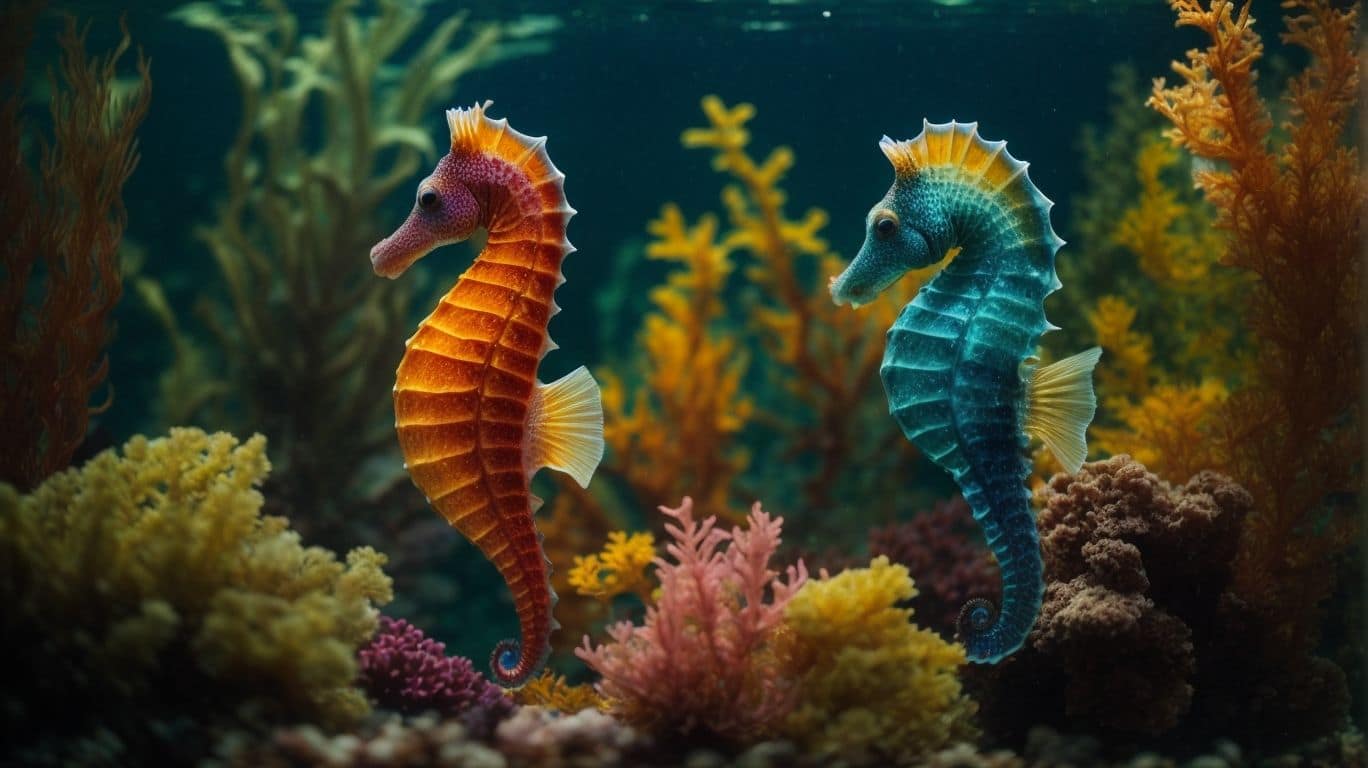
Photo Credits: Exoticaquaticpets.Com by Jeremy Campbell
When choosing seahorses for your home aquarium, there are key factors to consider that will ensure a healthy and thriving aquatic environment. From the size of the tank to seahorse compatibility, water parameters, and feeding requirements, we’ll dive into each sub-section to help you make informed choices.
So, let’s explore the essential considerations that will lead to a successful and enjoyable seahorse-keeping experience, backed by valuable insights from experts in the field.
Size of the Tank
When choosing a tank for seahorses in your home aquarium, it is crucial to consider the size of the tank for the well-being of these delicate creatures.
- Seahorses require a tank that is large enough to accommodate their unique characteristics. It is recommended to have a minimum tank size of 30 gallons to provide them with ample space to swim and explore.
- Vertical space: Seahorses are vertical swimmers and prefer tall tanks rather than long ones. An 18-inch-high tank allows them to exhibit their natural behavior.
- Filtration system: A larger tank size enables the installation of an appropriate filtration system, which is essential for maintaining water quality and preventing the buildup of ammonia and nitrites.
- Maintaining stability: A larger tank volume promotes stability in water parameters such as temperature, pH levels, and salinity, all of which are critical for seahorse health.
- Room for tank decor: A larger tank size provides enough space for live rock, corals, and seahorse-friendly tank decor, creating a natural and stimulating environment.
Seahorse Compatibility
Seahorse compatibility is crucial when selecting seahorses for your home aquarium. Consider the size of the tank, water parameters, and compatible tankmates.
| Factors | Description |
|---|---|
| Size of the Tank | Ensure the tank is spacious enough for the seahorses to roam and explore. A larger tank reduces stress and territorial aggression. |
| Water Parameters | Maintain stable water conditions with appropriate temperature, salinity, and pH levels. Seahorses are sensitive to fluctuations in water quality. |
| Compatible Tank Mates | Choose non-aggressive and slow-moving fish species as tank mates, such as gobies or pipefish. Avoid aggressive or fin-nipping fish that may harm the seahorses. |
Water Parameters
The water parameters are crucial for maintaining a healthy and stable environment for seahorses in a home aquarium. In order to ensure the overall health and well-being of these delicate creatures, it is essential to regularly test and make proper adjustments to the temperature, pH level, salinity, ammonia, nitrite, nitrate, calcium levels, and alkalinity of the water. The recommended water parameters for a seahorse aquarium are as follows:
| Parameter | Recommended Range |
|---|---|
| Temperature | Between 72°F and 78°F (22°C – 26°C) |
| pH level | Between 8.1 and 8.4 |
| Salinity | Between 1.020 and 1.026 |
| Ammonia | It should be 0 ppm |
| Nitrite | It should be 0 ppm |
| Nitrate | Should be below 10 ppm |
| Calcium levels | Between 400 ppm and 450 ppm |
| Alkalinity | Between 150 ppm and 200 ppm |
By maintaining these water parameters within the appropriate ranges, you can provide a suitable habitat for the seahorses in your aquarium.
Feeding Requirements
Feeding seahorses in a home aquarium requires careful attention to their unique dietary needs. Here is a table summarizing the feeding requirements for seahorses:
| Seahorse Species | Feeding Habits | Dietary Preferences | Recommended Foods |
| Hippocampus erectus | Active hunters | Prefer live foods | Mysis shrimp, brine shrimp |
| Hippocampus kuda | Passive hunters | Prefer small, slow-moving prey | Ghost shrimp, frozen mysis shrimp |
| Hippocampus reidi | Active hunters | Prefer small, fast-moving prey | Live brine shrimp, small live fish |
| Hippocampus zosterae | Passive hunters | Prefer very small prey | Live copepods, rotifers |
To ensure a healthy diet for seahorses, it’s best to offer a variety of food types and sizes. Live foods should be provided whenever possible, as they closely mimic their natural diet. It’s important to monitor the water quality and remove any uneaten food to prevent water contamination.
Regular feeding schedules and observation of seahorse behavior will help ensure they are getting enough nutrition. Remember to research the specific dietary needs of the seahorse species you choose for your aquarium.
Popular Seahorse Species for Home Aquariums
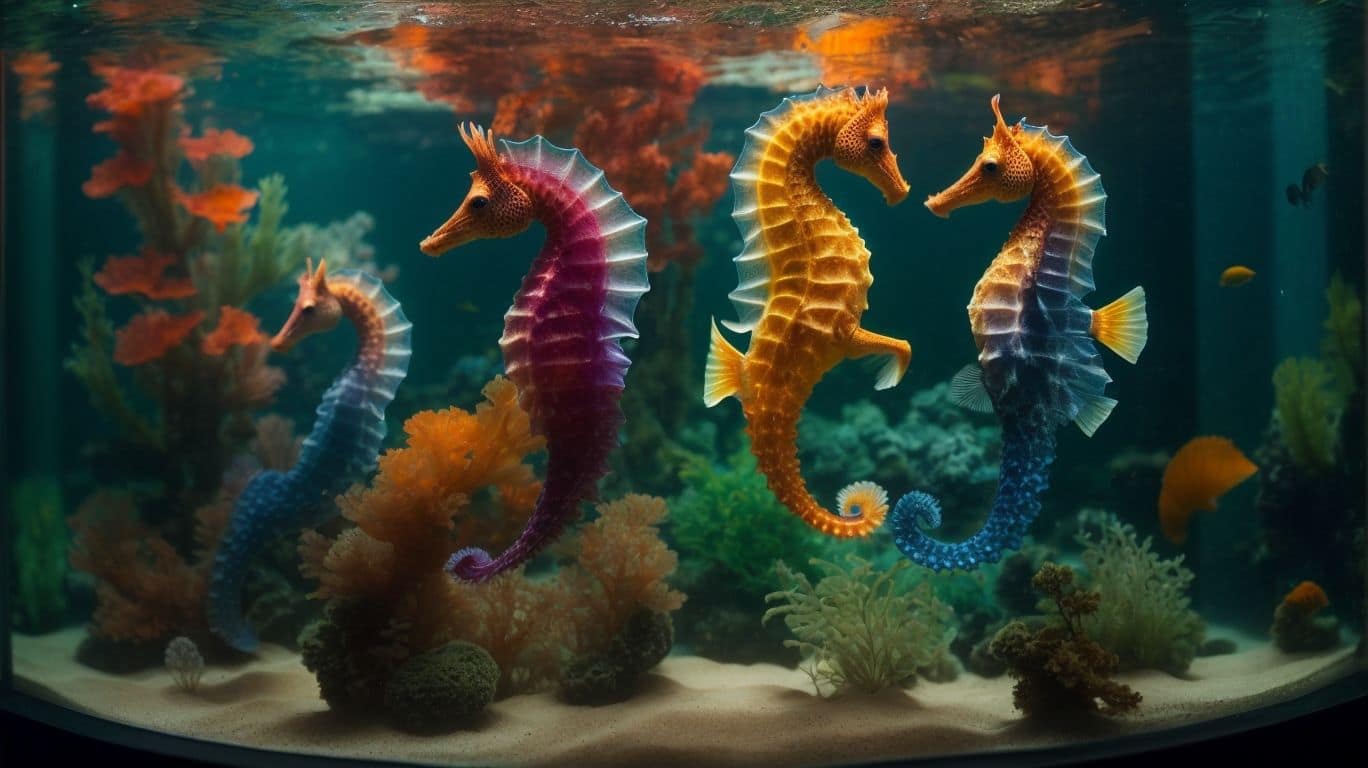
Photo Credits: Exoticaquaticpets.Com by Eric Hall
When it comes to creating a captivating and lively home aquarium, the choice of seahorse species is crucial. In this section, we uncover the popular seahorse species that are well-suited for home aquariums.
Get ready to dive into the enchanting world of Hippocampus erectus, Hippocampus kuda, Hippocampus reidi and Hippocampus zosterae. Each sub-section will reveal fascinating insights about these seahorses, their unique characteristics, and why they are highly sought after by aquarium enthusiasts. Prepare to be mesmerized by their beauty and charm!
Hippocampus erectus
Hippocampus erectus, commonly known as the Lined Seahorse, is a popular species for home aquariums. These seahorses are known for their camouflaging abilities and intricate patterns. When considering adding Hippocampus erectus to your aquarium, there are a few important factors to consider.
The size of the tank should be appropriate for their growth and movement. Ensure compatibility with other tankmates, as seahorses are peaceful creatures.
Maintaining proper water parameters, such as temperature and salinity, is crucial for their well-being. Providing a balanced diet of live or frozen foods is essential for their nutrition. By considering these factors, you can create a suitable habitat for Hippocampus erectus in your home aquarium.
Hippocampus kuda
The Hippocampus kuda, also known as the Common Seahorse, is a popular choice for home aquariums due to its captivating appearance and relatively easy care requirements.
Here is a table highlighting some key characteristics of the Hippocampus kuda:
| Common Name | Hippocampus kuda |
|---|---|
| Maximum Size | Up to 7 inches |
| Water Parameters | Temperature: 72-80°F Salinity: 1.020-1.025 |
| Diet | Carnivorous |
| Compatibility | Best kept in species-only tanks or with peaceful tank mates |
To ensure the well-being of your Hippocampus kuda, maintain a stable tank environment with appropriate filtration and regular water quality maintenance. Provide a varied diet of small-sized live or frozen foods to meet their nutritional needs.
Monitor their compatibility with tankmates to avoid any aggression or stress. Enjoy the beauty and unique behaviors of the Hippocampus kuda in your home aquarium.
Hippocampus reidi
Hippocampus reidi, commonly known as the Reidi Seahorse, is a popular choice for home aquariums due to its vibrant colors and unique characteristics. Here is a table highlighting key information about this seahorse species:
| Attribute | Description |
|---|---|
| Size | 4-7 inches |
| Lifespan | 2-4 years |
| Habitat | Found in shallow, warm waters of the Caribbean |
| Diet | Carnivorous, feeding on small crustaceans |
| Temperament | Peaceful and relatively easy to care for |
| Tank Size | Minimum 30-gallon tank |
| Water Parameters | Temperature: 74-78°F; Salinity: 1.020-1.025 |
Hippocampus reidi is a captivating addition to any home aquarium, but proper care and attention to water quality are essential for their well-being. Ensure to provide a suitable tank setup, maintain proper water parameters, and feed them a varied diet to promote their health and longevity.
Hippocampus zosterae
Hippocampus zosterae, commonly known as the dwarf seahorse, is a popular choice for home aquariums due to its small size and vibrant colors. These seahorses are native to the shallow waters of the Gulf of Mexico and the Caribbean Sea.
They, being Hippocampus zosterae, require a smaller tank size compared to other seahorse species, typically around 5 gallons. It is important to closely monitor water parameters, such as temperature and salinity, to ensure a healthy environment for the Hippocampus zosterae.
Feeding them small live foods like brine shrimp or copepods is necessary to meet the dietary needs of Hippocampus zosterae. Providing plenty of live plants and natural hiding spots will help create a suitable habitat for these fascinating creatures.
Caring for Seahorses in a Home Aquarium
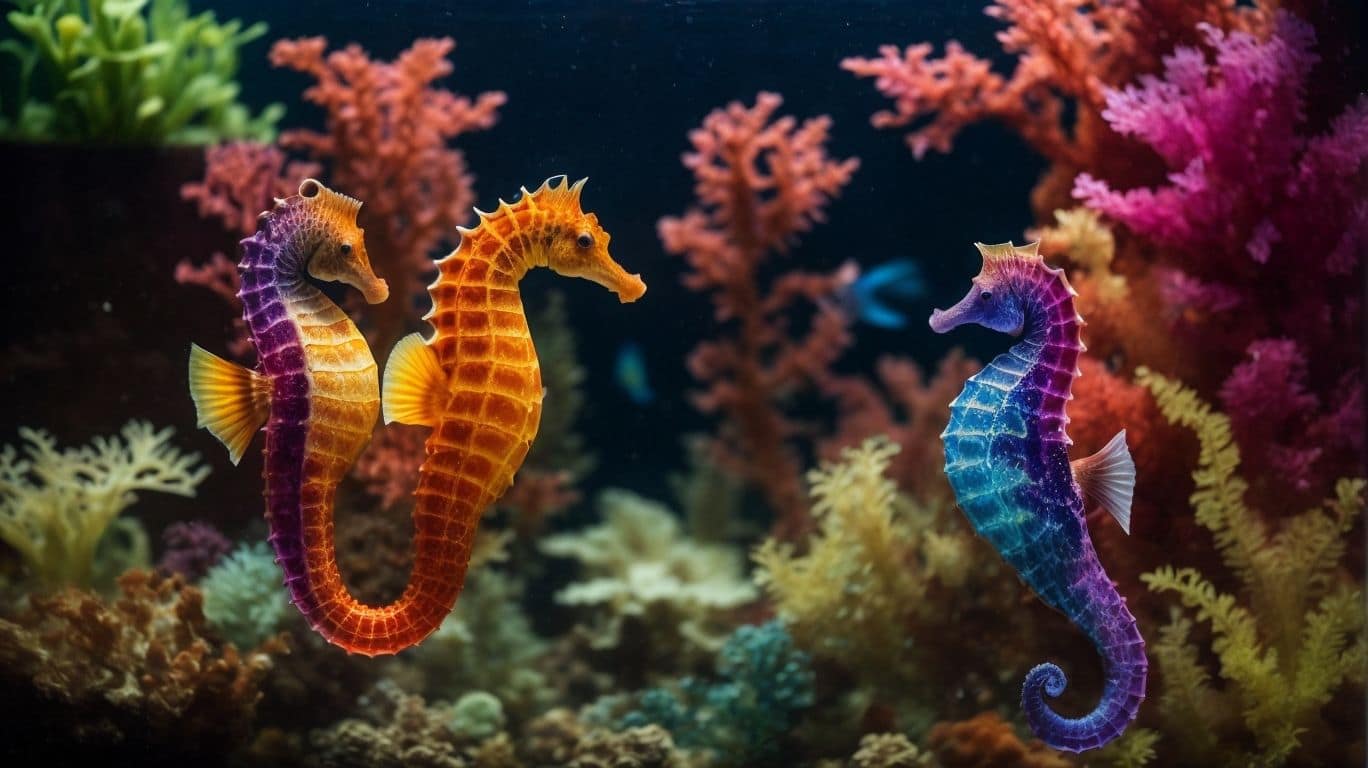
Photo Credits: Exoticaquaticpets.Com by Kenneth Martin
Caring for seahorses in a home aquarium opens up a world of wonder and responsibility. Dive into the depths of seahorse care, where we’ll explore their unique needs, from their delicate immune systems to the importance of choosing compatible tank mates.
Discover the secrets to creating a seahorse aquarium that offers the perfect environment for these enchanting creatures to thrive. Get ready to embark on a journey that brings the beauty of the ocean into your own home.
Tank Setup and Decoration
Setting up and decorating a tank for seahorses requires careful consideration to create a suitable and visually appealing environment for these delicate creatures. When it comes to tank setup and decoration, you should follow specific guidelines to ensure the well-being of your seahorses.
- Choose an appropriate tank size, with a minimum of 30 gallons, to accommodate seahorses’ unique needs for their tank setup and decoration.
- Provide ample vertical space to accommodate their natural upward positioning with tall tanks that are perfect for their tank setup and decoration.
- Use live rock or artificial structures to create hiding spots and perches for seahorses, which are important components of their tank setup and decoration.
- Select a soft substrate like sand to prevent any injuries to their delicate bodies and add more depth to their tank setup and decoration.
- Ensure a proper filtration system to maintain good water quality, as seahorses are sensitive to changes. This is crucial for their tank setup and decoration.
- Monitor and maintain stable water parameters, including temperature, salinity, and pH, to mimic their natural habitat, which greatly influences their tank setup and decoration.
- Consider adding live plants such as seagrass or macroalgae to provide shelter and enhance the biological filtration process as part of their tank setup and decoration.
- Decorate the tank with non-toxic, seahorse-safe ornaments and avoid any sharp edges or materials that could harm them. This is essential for their tank setup and decoration.
To create a captivating underwater environment, incorporate colorful decorations and elements that mimic their natural habitat, such as coral replicas or artificial seashells, which will enhance their tank setup and decoration.
Water Quality Maintenance
- Ensuring the proper maintenance of water quality is crucial for the health and well-being of seahorses in their tanks. Here are some important steps to follow:
- Regular Water Testing: It is important to regularly monitor the levels of ammonia, nitrite, nitrate, pH, and salinity to ensure that they fall within the appropriate range.
- Filtration System: Install a high-quality filtration system to effectively remove waste and maintain water clarity. Consider incorporating a protein skimmer to eliminate organic compounds.
- Water Changes: Perform regular partial water changes (10–20% weekly) to eliminate any accumulated toxins and replenish essential minerals.
- Clean and Maintain Equipment: Regularly clean and maintain filters, skimmers, and other equipment to prevent the buildup of debris and ensure optimal functioning.
- Avoid Overfeeding: Overfeeding can result in excess waste and water pollution. It is advisable to feed seahorses small and frequent meals, removing any uneaten food.
Remember, adhering to these steps will contribute to the overall maintenance of water quality, creating a clean and safe environment for your seahorses to thrive in.
Feeding Seahorses
- When it comes to feeding seahorses in a home aquarium, it is essential to understand their dietary needs. These slow eaters prefer small, frequent meals, primarily consisting of live foods like brine shrimp, plankton, and copepods.
- To maintain a healthy balance, offer a varied diet to your seahorses. This can be achieved by providing a mix of live and frozen foods, including frozen mysis shrimp, frozen cyclops, and enriched brine shrimp.
- Since seahorses have small stomachs, it is recommended to feed them at least 2-3 times a day. Make sure to space out the feedings, allowing them to fully digest each meal.
- Monitoring your seahorses’ feeding behavior is crucial. Keep an eye on the amount they consume, as overfeeding can cause health issues. Adjust the portion size based on their appetite and size.
- Consider supplementing their diet with vitamins to ensure your seahorses receive all the essential nutrients they need for a healthy life.
Feeding seahorses in a home aquarium requires careful attention to their specific needs. In the wild, these remarkable creatures rely on stealth and accuracy to capture their prey. By mimicking their natural feeding behavior, you can contribute to their overall well-being in your aquarium.
Seahorse Breeding and Reproduction
- When it comes to seahorse breeding and reproduction, careful planning and attention to their unique needs are essential.
- A key step is to prepare a separate breeding tank with appropriate temperature, salinity, and lighting conditions.
- In order to ensure successful breeding, it is important to carefully select a compatible pair of seahorses. These seahorses should be of similar sizes and from the same species.
- Provide hiding spaces, such as live plants or artificial structures, to allow the seahorses to anchor their tails and lay eggs.
- Observing courtship rituals, which include elaborate displays and dances, is necessary to ensure bonding between the pair.
- During the breeding process, it is important to monitor the female seahorse for signs of pregnancy, such as a distended belly and changes in coloration.
- Once the female seahorse is pregnant, it is crucial to transfer her to a separate birthing tank. This protects the fry from being eaten by other tankmates.
- Keeping the water conditions stable and providing a varied diet of live or frozen foods helps support the growth and development of the fry.
- Observing the birth process is fascinating, as the male seahorse gives birth to live fry through a specialized pouch.
- To prevent cannibalism and provide the fry with ample food and shelter, it is important to separate them from the parents.
- Regularly monitoring and maintaining water quality in both the breeding and fry tanks is vital for the health and survival of the seahorses.
Tips for Keeping Seahorses Healthy in Home Aquariums
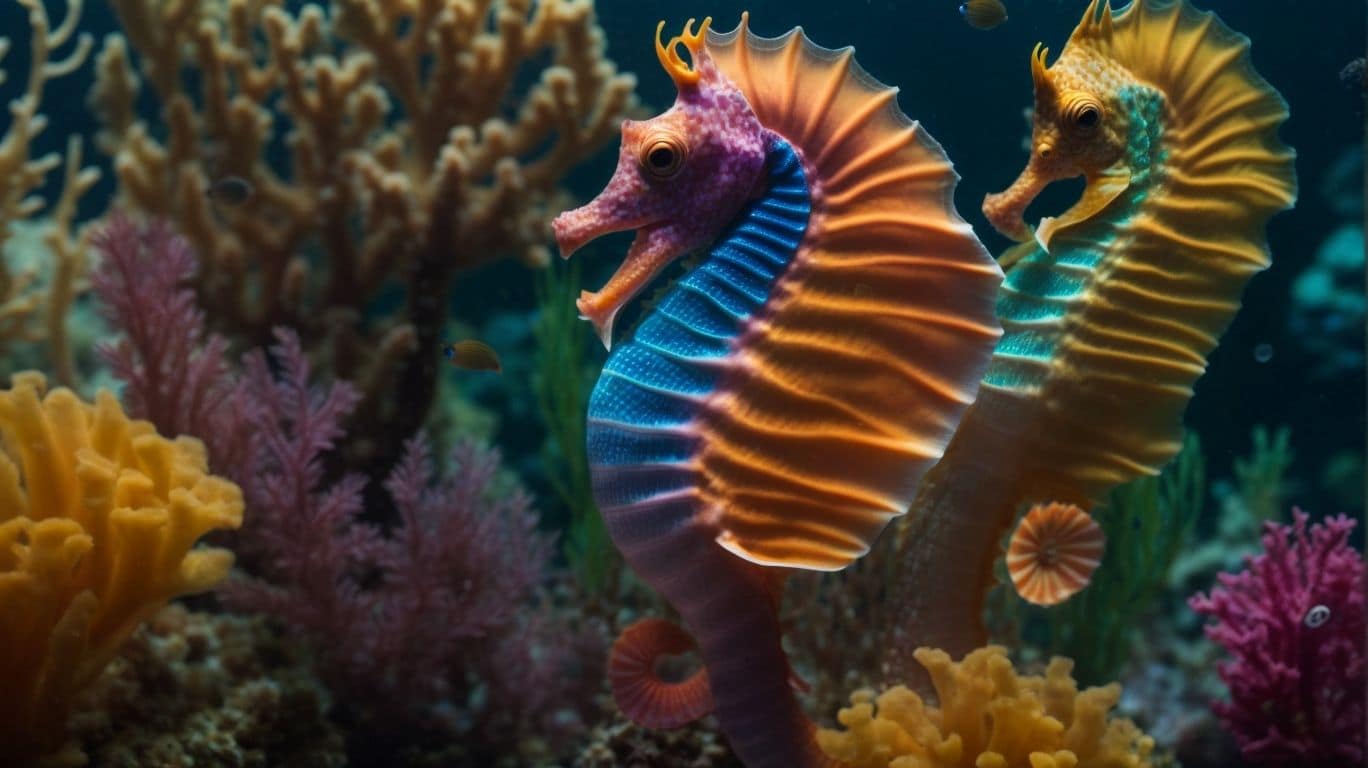
Photo Credits: Exoticaquaticpets.Com by John Gonzalez
Keeping seahorses in home aquariums requires special care to ensure their health and well-being. In this section, we’ll dive into invaluable tips and insights that will help you maintain the optimal conditions for seahorses in your aquarium.
From seahorse care and their unique life requirements to the impact of stress on their immune system, we’ll cover it all. We’ll explore the importance of choosing compatible tankmates and creating the perfect seahorse habitat within your aquarium. Get ready to make your home aquarium a thriving haven for these enchanting creatures.
Seahorse Care
Seahorse care is of utmost importance when it comes to maintaining the health and well-being of these delicate creatures in a home aquarium. Taking care of seahorses involves following a few essential steps:
- One crucial step is providing a suitable tank setup and decoration that mimics their natural habitat.
- An important part of seahorse care is maintaining optimal water quality. This can be achieved by regularly testing and monitoring water parameters.
- Another key aspect of caring for seahorses is feeding them a balanced diet, which can include live or frozen foods.
- If you are interested in expanding your seahorse population, it is vital to learn about seahorse breeding and reproduction.
- In order to avoid aggression and stress, it is important to ensure that seahorses have appropriate tankmates.
Fun Fact: Did you know that seahorses are unique in the animal kingdom as the male carries and gives birth to the offspring?
Seahorse Life and Care
- Caring for seahorses in a home aquarium requires attention to their unique life and care needs. Here are some considerations when it comes to seahorse care:
- Feeding: Seahorses have specific dietary requirements and should be fed small, frequent meals of live or frozen foods such as brine shrimp or mysis shrimp.
- Tank Setup: Seahorses need a tank with plenty of vertical structures like plants, corals, or artificial structures for them to hold onto with their tails.
- Water Quality: Maintaining stable water parameters, such as temperature, salinity, and pH, is crucial for the health of seahorses.
- Tank Mates: Choose tank mates carefully, as seahorses are slow swimmers and may struggle to compete for food with faster and more aggressive fish.
- Monitoring Stress: Seahorses are susceptible to stress, so it’s important to provide them with a calm and peaceful environment.
True story: A seahorse enthusiast named Sarah diligently cared for her seahorses by providing them with a well-maintained tank, feeding them a nutritious diet, and regularly monitoring their health. As a result, her seahorses thrived, displaying vibrant colors and unique behaviors, bringing her endless joy and fulfillment.
Stress on the Immune System
Stress on the immune system can have a substantial impact on seahorses in home aquariums. It is essential to minimize stressors to promote their overall health and well-being. Factors such as overcrowding, incompatible tankmates, poor water quality, and improper feeding practices can all contribute to elevated stress levels.
Providing a suitable tank setup, maintaining proper water parameters, and offering a balanced diet can help reduce the stress on the immune system of seahorses. Regular monitoring and promptly addressing any issues can significantly enhance the immune system of seahorses and ensure their long-term health in a home aquarium.
TankMates
When considering tank mates for seahorses in a home aquarium, it is crucial to select species that are compatible and can create a harmonious environment. Here are some popular tankmates that can peacefully coexist with seahorses:
- Small gobies
- Small blennies
- Small dartfish
- Firefish
- Cardinalfish
- Small anthias
- Some species of damsels
These tankmates should be non-aggressive and have similar water parameter requirements to ensure the well-being of both seahorses and their tankmates. It is always advisable to conduct thorough research and seek guidance from experts when choosing tankmates. This will ensure a compatible and thriving aquarium ecosystem.
Seahorse Aquarium
Creating a suitable seahorse aquarium involves considering various factors such as tank size, seahorse compatibility, water parameters, and feeding requirements.
- Tank size: To ensure seahorses have enough space to swim and hide, a minimum tank size of 30 gallons is necessary.
- Seahorse compatibility: It is important to avoid keeping aggressive or fast-moving fish with seahorses, as they may outcompete or stress them out while feeding.
- Water parameters: Proper maintenance of stable water temperature, salinity, and pH levels within the appropriate range is crucial for the well-being of seahorses.
- Feeding requirements: A diet consisting of small food items like live brine shrimp or frozen mysis shrimp, multiple times a day, should be provided to seahorses.
In addition, it is essential to properly set up and decorate the tank, maintain good water quality through regular maintenance, and consider options for seahorse breeding and reproduction. Creating and maintaining a thriving seahorse aquarium requires careful attention and understanding of seahorse care.
Suggestions: To gather more detailed information on seahorse aquariums, it is recommended to research reputable sources. Joining community forums or local aquarium clubs can also provide access to experienced seahorse keepers who can offer valuable advice.
Consulting with a marine biologist or seahorse care expert can further assist in creating and maintaining a successful seahorse aquarium.
Identifying Seahorse Species
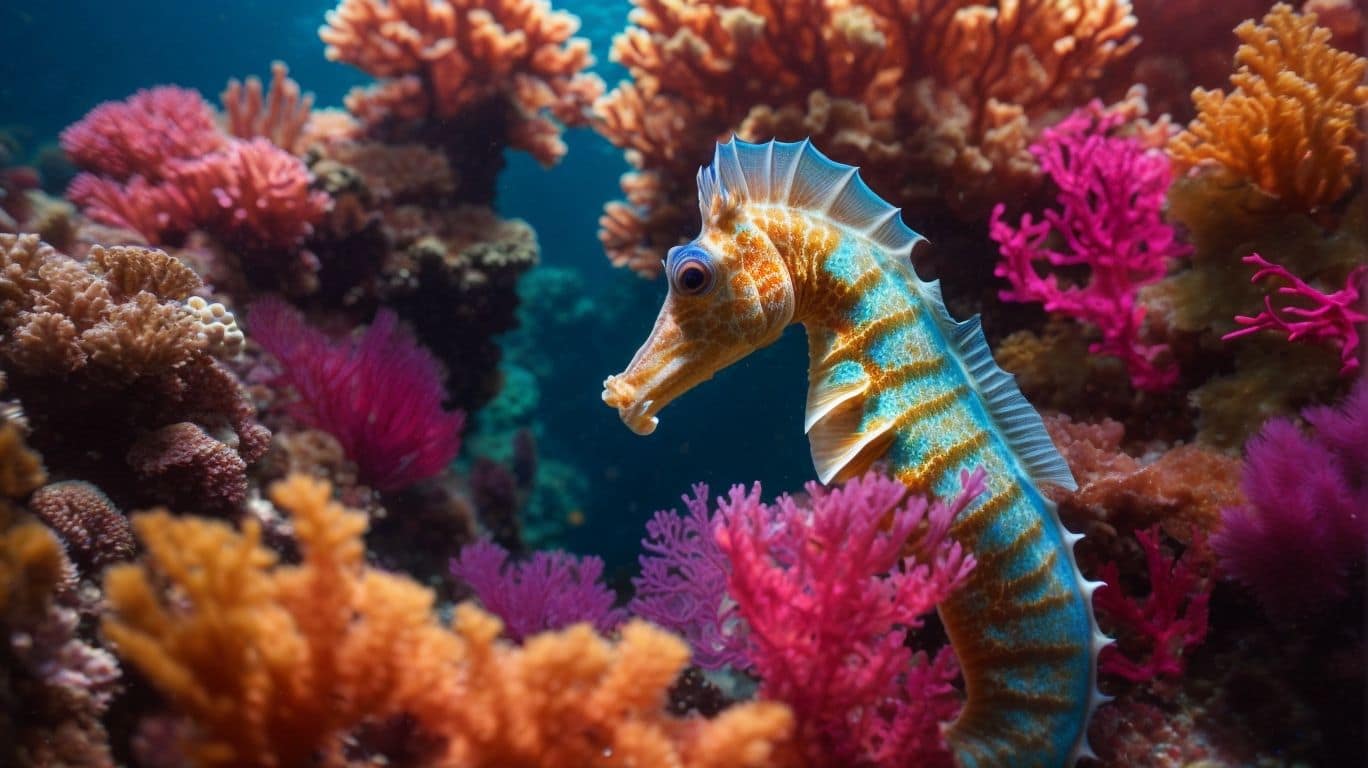
Photo Credits: Exoticaquaticpets.Com by Stephen Flores
Identifying seahorse species can be a challenging task due to their unique appearances. However, with the proper knowledge and keen observation, distinguishing between different seahorse species is possible. Here are some key characteristics to carefully examine:
– Body shape: Seahorses exhibit various shapes, such as slender, pot-bellied, and elongated.
– Snout length: It is important to note that certain species possess longer snouts while others have shorter ones.
– Spines: Pay close attention to the presence and arrangement of spines on their bodies.
– Colors and patterns: Seahorses display a wide range of vibrant hues and intricate patterns.
By closely examining these features, it becomes possible to successfully identify various seahorse species and truly appreciate their exceptional beauty.
True story: While snorkeling in the Caribbean, I once had the incredible opportunity to encounter a seahorse with a remarkably long snout and a vivid orange coloration. It turned out to be a Hippocampus reidi, commonly referred to as the Longsnout Seahorse. This distinct appearance made it an extraordinary discovery, creating a truly unforgettable experience that showcased the remarkable diversity of seahorse species thriving in the ocean.
Additional Information and Resources
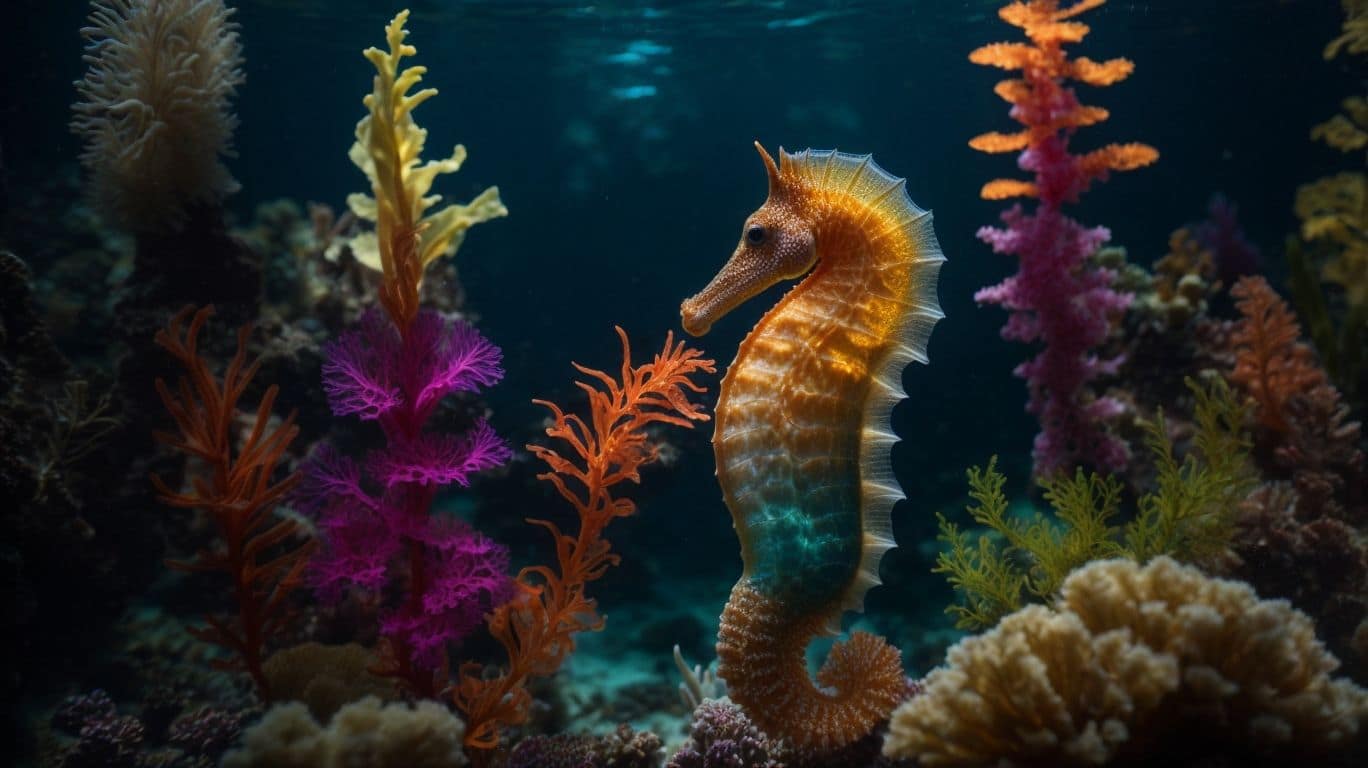
Photo Credits: Exoticaquaticpets.Com by Elijah Rodriguez
When considering seahorses for home aquariums, it is important to have additional information and resources to ensure their well-being.
- Proper Care: Research the specific needs of the seahorse species you are interested in, such as tank size and temperature requirements.
- Feeding: Seahorses have unique feeding habits. Learn about their diet and provide them with appropriate food, such as live or frozen shrimp.
- Aquarium Setup: Create a suitable environment with plants, rocks, and hiding spots to mimic their natural habitat.
- Water Conditions: Maintain optimal water quality by regularly testing parameters like pH, salinity, and ammonia levels.
- Interaction: Avoid excessive handling, as seahorses are delicate creatures. Observe them from a distance to minimize stress.
With additional information and resources, you can ensure the proper care and well-being of your seahorses. Research the specific needs of the seahorse species you are interested in, such as tank size and temperature requirements.
Learn about their unique feeding habits and provide them with appropriate food, such as live or frozen shrimp. Create a suitable aquarium setup that mimics their natural habitat with plants, rocks, and hiding spots. Regularly test water parameters like pH, salinity, and ammonia levels to maintain optimal water conditions.
Remember to interact with your seahorses cautiously, minimizing stress by avoiding excessive handling. By incorporating additional information and resources, you can create a thriving home aquarium that captivates all who see it.
Some Facts About the Best Seahorse Species for Home Aquariums:
- ✅ Seahorses require excellent water quality and are picky eaters. (Source: Our Team)
- ✅ Keeping seahorses in captivity is extremely challenging and should only be attempted by expert aquarists. (Source: Our Team)
- ✅ Seahorses are best kept in seahorse-only tanks as they are easily intimidated by active fish. (Source: Our Team)
- ✅ The Dwarf Seahorse is the most commonly found seahorse species in the aquarium trade. (Source: Our Team)
- ✅ When choosing seahorses, it is important to match the new water parameters during water changes to avoid causing stress or harm. (Source: Our Team)
Frequently Asked Questions
What is the best seahorse species for a home aquarium?
The best seahorse species for a home aquarium would depend on the size of the tank and the experience level of the aquarist. The Dwarf Seahorse is the most commonly found species and is suitable for smaller tanks. However, for larger tanks, species like H. Erectus or H. Reidi can be a great choice.
Can I mix different seahorse species in the same aquarium?
It is not recommended to mix different seahorse species in the same aquarium. Mixing species may result in stress, health issues, and compatibility problems. Each species may carry different microfauna that can cause harm to other species.
What tank size is recommended for seahorses?
The tank size for seahorses depends on the species. For larger seahorse species like H. Erectus or H. Reidi, a minimum tank size of 30 gallons is recommended for the first pair, with an additional 15 gallons for each additional pair. However, smaller species like the Dwarf Seahorse can be kept in smaller tank sizes, such as a 10-gallon hex tank.
Do seahorses require social fish companions?
No, seahorses do not require other fish companions. In fact, it is best to keep seahorses in seahorse-only tanks. Seahorses are highly social and mate for life, so they thrive better in a species-specific environment.
What are the requirements for maintaining water quality in a seahorse aquarium?
Maintaining excellent water quality is crucial for seahorses. It is important to perform regular water changes and match the parameters of the new water to avoid causing stress or harm to the seahorses. Having extra water volume in the aquarium can help create a more stable environment for the seahorses.
Are seahorses susceptible to bacterial-related issues?
Yes, seahorses have a primitive immune system and are more susceptible to bacterial-related issues compared to other fish. It is important to ensure good water quality and cleanliness in the tank to minimize the risk of bacterial infections.

